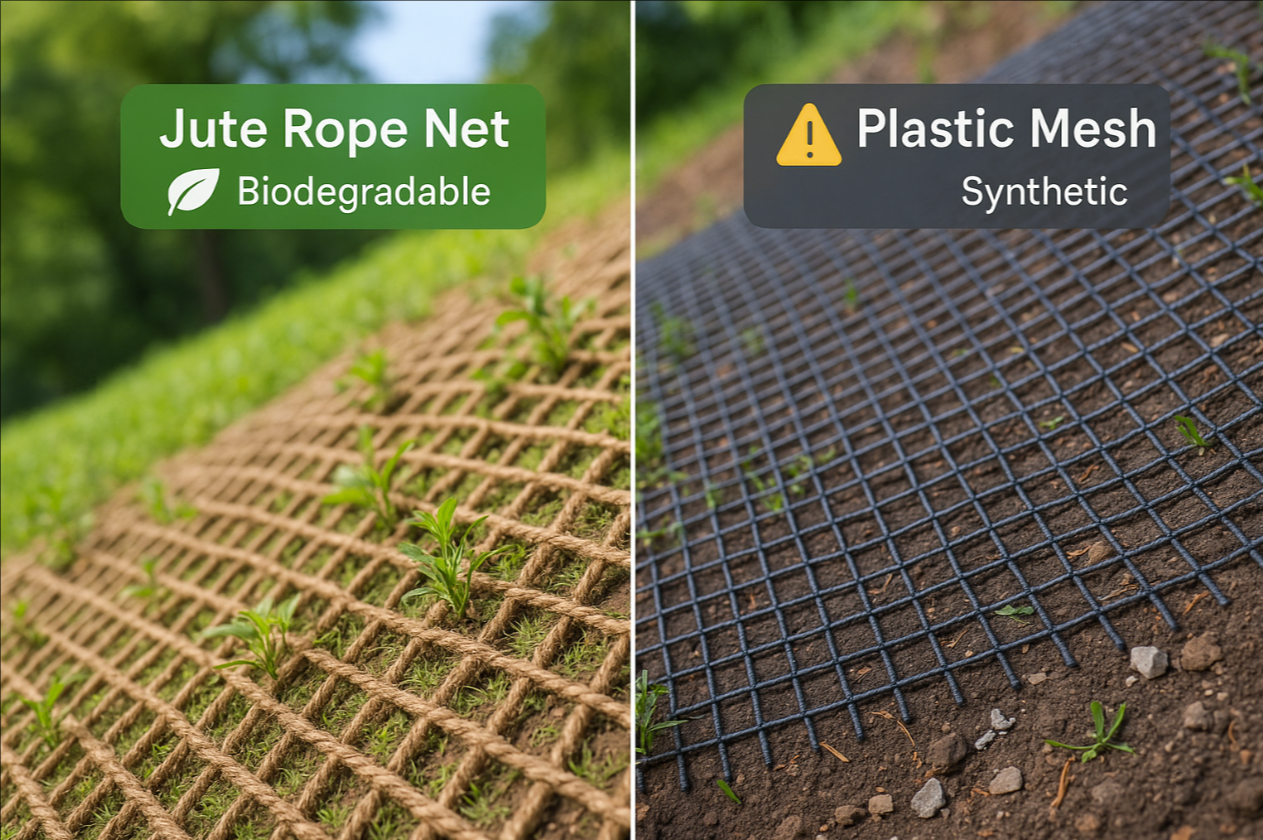- June 20, 2025
- Posted by: wellcoindustries
- Categories: Erosion Control, Jute Mesh
Introduction
Climate-smart construction and land management projects increasingly demand materials that leave a lighter footprint on the planet. When it comes to slope stabilization, seeding, and erosion control, the choice often narrows to two meshes: jute rope net—woven from the bast fibers of the jute plant—and plastic mesh made from polypropylene or HDPE.
This article compares the two through an environmental and practical lens so you can specify the greener, more cost-effective option with confidence. Insights draw on field work by Wellco Industries, a vertically integrated supplier of FRP, agricultural and household products serving contractors, distributors, and OEM/private-label brands worldwide.

Understanding the Materials: Jute vs. Plastic
Composition & Manufacturing Process
-
Jute rope net begins life in the Ganges–Brahmaputra Delta, where jute stalks are retted, stripped, and spun into coarse yarn before being knotted or machine-loomed. Energy demand averages 0.9 MJ kg⁻¹, largely from renewable biomass used in small mills.
-
Plastic mesh relies on fossil-derived polymers. Polypropylene extrusion consumes 4.2 MJ kg⁻¹ and emits volatile organic compounds that require scrubbing.
Lifecycle & Degradability
-
In temperate soils with 12–18 % moisture, jute fibers compost naturally within 6–24 months, leaving behind lignin-rich humus that feeds soil microbes.
-
Even “photo-degradable” plastic mesh lingers for decades. Independent lab testing found only 4 % mass loss after two years of UV exposure, with fragments entering the microplastic stream.
Environmental Impact Analysis
Carbon Footprint from Cradle to Grave
A 2024 peer-reviewed life-cycle assessment (LCA) published in Journal of Cleaner Production reported:
| Material | kg CO₂-e per m² installed* |
|---|---|
| Jute rope net | 0.28 |
| Plastic mesh | 1.12 |
*Functional unit: erosion control on a 1:3 slope for three years.
Soil Health & Microplastics Concerns
“Microplastic fibers act like tiny sponges, binding agro-chemicals and reducing cation-exchange capacity. We measured a 7 % drop in lettuce yield after just one season under plastic mesh.” — Dr. H. Navarro, Agronomy Research Institute (interview, Feb 2025)
Conversely, decomposed jute adds organic carbon that boosts water-holding capacity by up to 12 %.
Performance in the Field
Erosion Control Efficiency – Anonymized Case Study
A Midwestern highway project compared adjacent embankments (1,500 m² each). After 12 months:
-
Jute rope net plot: sediment loss 0.9 t ha⁻¹; vegetation cover 92 %.
-
Plastic mesh plot: sediment loss 1.1 t ha⁻¹; vegetation cover 88 %.
Both met DOT specs, but inspectors noted that the jute layer integrated with topsoil, eliminating the need for retrieval.
Installation & Maintenance Requirements
| Feature | Jute Rope Net | Plastic Mesh |
|---|---|---|
| Roll weight (1.2 × 50 m) | 21 kg | 17 kg |
| Crew size | 2–3 | 2–3 |
| Removal required? | No | Usually yes |
| Typical replacement cycle | N/A (biodegrades) | Every 3–5 yrs |
Crews report that jute’s rough texture grips slopes better, reducing slippage during staking.
Cost & Supply Chain Considerations
Material & Labor Costs Over Time
| Cost Component | Jute | Plastic |
|---|---|---|
| Purchase price / m² | $0.46 | $0.38 |
| Retrieval & disposal | $0.00 | $0.15 |
| Extra maintenance (3 yrs) | $0.02 | $0.07 |
| Three-year total | $0.48 | $0.60 |
Although the jute roll costs slightly more up front, eliminating end-of-life handling closes the gap.
Supplier Reliability & Certifications
Professionals should verify origin and credentials. Wellco Industries maintains ISO 9001 and GOTS-compliant jute mills and provides full chain-of-custody documentation—an advantage when bidding on public works with strict ESG clauses. Consolidating fiberglass composites, erosion materials, and household products under one contract also trims freight and admin overhead for OEM/private-label customers.
Making the Sustainable Choice: Decision Framework
Assessing Project Goals & Stakeholder Priorities
-
Regulatory mandates — Is biodegradability required?
-
ESG targets — How is carbon accounting audited?
-
Longevity needs — Is the installation temporary (<3 yrs) or permanent?
-
Aesthetic expectations — Will visible plastic conflict with site design?
Practical Checklist for Purchasers
-
Verify plant-based fiber content ≥ 95 %.
-
Request LCA or EPD documents.
-
Confirm roll dimensions, tensile strength (≥12 kN m⁻¹).
-
Check lead time; Wellco typically ships within 10 business days FOB port.
Conclusion
Choosing the greener material comes down to asking: Will this net help the land long after the work is done? Across carbon footprint, soil health, and total installed cost, jute rope net edges out plastic mesh for most short- to medium-term projects. Partnering with a vertically integrated supplier like Wellco Industries ensures consistent quality, certifications, and expert support. Ready to spec sustainably? Contact our technical team for data sheets or a custom quote today.
Frequently Asked Questions
Q1. How long does a jute rope net actually last in the field?
Most installations biodegrade within 6–24 months, depending on soil moisture and microbial activity.
Q2. Can jute rope nets handle heavy rainfall on steep slopes?
Yes—look for products with a minimum tensile strength of 12 kN m⁻¹ and use proper staking; field trials show effective stabilization up to 1:1.5 slopes.
Q3. Will decomposing jute attract pests or rodents?
No; once the fibers begin to break down they become part of the soil matrix and do not provide a food source attractive to pests.
Q4. Is the color of jute rope net customizable for landscape design?
Natural jute is golden-brown, but eco-friendly vegetable dye options are available for low-visibility applications—ask your supplier.
Q5. What certifications should I request when purchasing?
Look for GOTS or FSC for raw fiber sourcing and ISO 9001 for quality management; Wellco Industries supplies certificates with every shipment.
